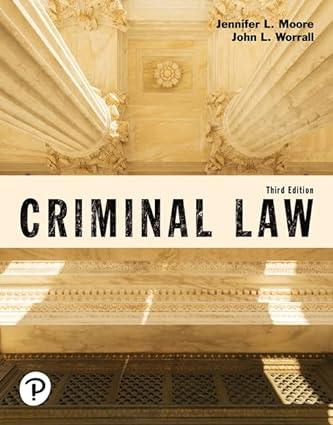Evelyn Soto was convicted of drug conspiracy in the Southern District of New York. Soto appealed and
Question:
Evelyn Soto was convicted of drug conspiracy in the Southern District of New York. Soto appealed and the Second Circuit Court of Appeals reversed her conviction.
. . . The basic facts are not in dispute. At the trial the government presented the testimony of four Drug Enforcement Administration (DEA) special agents. In essence their testimony established that Soto resided in a Bronx apartment located at 2526 Bronx Park East, 5-B, which was used, in part, as a narcotics “cutting mill.”
The government’s chief witness was DEA Agent Fred Marrero.
Agent Marrero testified that in his role as an undercover agent he met the person in charge of the cutting mill—a man known as “Cheo”—on June 29, 1982 . . . Following a tip from a confidential informant, DEA Agents Thomas Ward and Marrero made several arrests and seized a cache of guns and drugs at the apartment in the early morning hours of July 2, 1982.
At the time of the agents’ entry into the apartment, Agent Ward found Soto and her young child asleep in the bedroom.
A search of that room uncovered drugs, drug paraphernalia and a weapon. A search of the rest of the apartment reaped a large quantity of drugs, drug paraphernalia, cash and more weapons. Although the apartment contained a substantial amount of contraband, it is equally clear that apartment 5-B was more than just a cutting mill—it was also a domicile for several individuals, including Soto, being furnished with couches, sleeping cots and a television set.
Two stipulations were also made part of the record. The first provided that Soto arrived in New York from Puerto Rico on or about June 8, 1982; that she resided at 2526 Bronx Park East, apartment 5-B, from June 8, through July 2; and that apartment 5-B was leased in the name of Pablo Rodriguez but, in reality, was paid for and controlled by Cheo and his wife, Nancy Medina. The second stipulation specified that ledger books found during the search of the apartment were examined by government experts for fingerprints and handwriting; that Soto’s fingerprints were not identified, but those of Cheo and his wife were; and that Soto’s handwriting was not identified as appearing anywhere on the ledger sheets.
In this connection, Marrero testified that the ledger books contained a list of Cheo’s employees and their salaries, but did not contain Soto’s name.
Against this background, we address Soto’s principal contention that the evidence was insufficient as a matter of law to convict her beyond a reasonable doubt . . . The most significant circumstance relied on by the government in support of the jury’s finding of guilt is the fact that Soto lived in apartment 5-B for three weeks prior to her arrest.
Her sustained and regular presence in that apartment, the government contends, is circumstantial evidence from which the jury could infer defendant’s membership in the narcotics and firearms conspiracies.
We are constrained to disagree. While it would not be accurate to characterize Soto’s presence at the apartment as merely transitory, we nevertheless consider the total circumstances of how Soto came to reside there to be highly significant. For here we have an individual newly arrived from Puerto Rico, accompanied by a child of tender years, clearly in need of shelter. To this end, as soon as she arrived in New York defendant took up residence at the 2526 Bronx Park East apartment. Although the living arrangements there may not have been ideal, there is no indication that defendant had any other alternative.
As defendant correctly observes, and as the government necessarily concedes, Soto’s mere presence at the apartment, even coupled with the knowledge that a crime was being committed there, is not sufficient to establish her guilt. Evidence tending to show knowing participation in the conspiracy is also needed. Absent some showing of purposeful behavior tending to connect defendant with the acquisition, concealment, importation, use or sale of drugs or firearms, participation in the conspiracies cannot be proven by presence alone.
. . . Finally, we find misplaced the government’s reliance on those cases where members of a vessel’s crew were held to be participants in a drug conspiracy. There, the existence of a joint enterprise is inferable in view of the close relationship among those on board, coupled with the foreknowledge of the vessel’s illicit mission given the large quantities of contraband frequently involved.
Here, by contrast, there is no comparable showing or even the slightest suggestion that Soto had knowledge of the ongoing drug mill activities before moving into the Bronx apartment.
Moreover, considering the absence of her name from the list maintained by Cheo of persons he employed in the furtherance of the drug operation, the inescapable inference to be drawn from the evidence is that she never joined the conspiracy.
In sum, while the evidence need not have excluded every possible hypothesis of innocence, nevertheless, “[w]here the crime charged is conspiracy, a conviction cannot be sustained unless the Government establishes beyond a reasonable doubt that the defendant had the specific intent to violate the substantive statute[s].” The government here produced no evidence whatever linking defendant to the conspiracies.
Instead, we believe that on the basis of association alone, the jurors “let their imaginations run rampant.”
Because we decide that there was insufficient evidence to support a conviction . . . the judgment of the district court is reversed and remanded with direction to enter a judgment of acquittal.
Questions:-
1. List all of the facts that support the government’s argument that Defendant Soto engaged in a drug conspiracy.
2. Is Soto’s knowledge of the illegal activity in her apartment sufficient to find her guilty of any crime? Why or why not?
Step by Step Answer:






